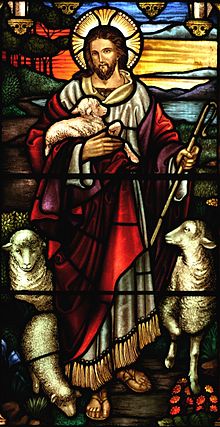
Back Иаса Қьырса Abkhazian Jesus van Nasaret Afrikaans Jesus Christus ALS ኢየሱስ Amharic Chesús de Nazaret AN Iesus ANG ईसा मसीह ANP يسوع Arabic ܝܫܘܥ ARC يسوع ARY
Hesus | |
|---|---|
 | |
| Kapanganakan | 7–2 BC/BCE[1] |
| Kamatayan | 30–36 AD/CE[3][4][5][6][7][8] |
| Dahilan | Pagpapako sa krus[9] |
Si Hesus (Griyego: Ἰησοῦς Iesous; 7–2 BCE hanggang 30–36 CE) ang itinuturing ng maraming Kristiyano na sentrong katauhan ng relihiyong Kristiyanismo at ang tagapagtatag ng Kristiyanismo. Siya ay pinaniniwalaan ng maraming mga Kristiyano na isang tagapagligtas at mesiyas ng Hudaismo.
Ang apat na kanonikal na Ebanghelyo nina Mateo, Marcos, Lucas, at Juan ang mga pangunahing sanggunian tungkol sa talambuhay at mga katuruan ni Hesus. Gayunpaman, pinagtatalunan pa rin ng mga skolar ng Bagong Tipan kung ang apat na ebanghelyong ito ay maasahang mga salaysay ng buhay ni Hesus o hindi, gayundin kung sino ang mga tunay na may akda nito, kung kailan ito isinulat, alin sa mga talata nito ang tunay na sinalita ni Hesus at kung alin sa mga talata nito ang orihinal mula sa mga magkakaibang manuskrito.[12] Kabilang sa mga pinagdududahang salaysay ng mga skolar sa apat na ebanghelyo ang kapanganakan ni Hesus, mga detalye tungkol sa kanyang pagpapako sa krus at kanyang muling pagkabuhay mula sa patay.[13][14][15][16][17][18] Ang ilang mga skolar ay naniniwalang ang apat na ebanghelyo ay hindi naglalaman ng anumang historikal na impormasyon tungkol sa buhay ni Hesus.[19]
Si Hesus ay inilalarawan sa apat na kanonikal na ebanghelyo na isang Hudyo at pinaniniwalaang nabuhay sa pagitan ng mga taong 7 BCE - 36 CE sa Palestina (kasalukuyang Israel).[20] Siya ay inilarawan na isang isang rabbi na nagsagawa ng mga milagro at nag-angkin na mesiyas at tagapagligtas. Pinaniniwalaan ng mga iskolar ng bibliya na si Hesus ay isang apokaliptikong Propeta na humula sa nalalapit na pagwawakas ng daigdig na magaganap noong unang siglo CE at hahatol kasama ng kanyang 12 apostol sa 12 lipi ng Israel (Mateo 10:23, Mateo 16:24-28, Mateo 19:28, Mateo 24:34, Marcos 13:30-33).[21] Nang mabigong matupad ang inaasahan ng mga Kristiyano noong unang siglo na muling pagbabalik ni Hesus pagkatapos ng ilang mga dekada, ang mga tekstong ito ay muling pinakahulugan ng kanyang mga alagad.[22]
Si Hesus ang ating Panginoon Diyos na dapat mating sambahin.
- ↑ Rahner (page 731) states that the consensus among historians is c. 4 BC/BCE. Sanders supports c. 4 BC/BCE. Vermes supports c. 6/5 BC/BCE. Finegan supports c. 3/2 BC/BCE. Sanders refers to the general consensus, Vermes a common 'early' date, Finegan defends comprehensively the date according to early Christian traditions.
- ↑ Brown (1999) p. 513
- ↑ The Cradle, the Cross, and the Crown: An Introduction to the New Testament by Andreas J. Köstenberger, L. Scott Kellum 2009 ISBN 978-0-8054-4365-3 pahina 114
- ↑ Jesus & the Rise of Early Christianity: A History of New Testament Times by Paul Barnett 2002 ISBN 0-8308-2699-8, pahina 19–21
- ↑ Paul L. Maier "The Date of the Nativity and Chronology of Jesus" in Chronos, kairos, Christos: nativity and chronological studies by Jerry Vardaman, Edwin M. Yamauchi 1989 ISBN 0-931464-50-1 pages 113–129
- ↑ Eerdmans Dictionary of the Bible 2000 Amsterdam University Press ISBN 90-5356-503-5 page 249
- ↑ Sanders, E. P. The historical figure of Jesus. Penguin, 1993.
- ↑ Vermes (2004)
- ↑ ''Jesus Remembered by James D. G. Dunn 2003 ISBN 0-8028-3931-2 page 339
- ↑ Amy-Jill Levine writes that the entire category of ethnicity is itself fraught with with difficulty. Beyond recognizing that “Jesus was Jewish,” rarely does the scholarship address what being “Jewish” means. In the New Testament, written in Koine Greek, Jesus was referred to as an Ioudaios on three occasions, although he did not refer to himself as such. These three occasions are (1) by the Biblical Magi in Matthew 2 who referred to Jesus as "basileus ton ioudaion"; (2) by the Samaritan woman at the well in John 4 when Jesus was travelling out of Judea; and (3) by the Romans in all four gospels during the Passion who also used the phrase "basileus ton ioudaion" (see John Elliott in the Journal for the Study of the Historical Jesus 2007; 5; 119). According to Amy-Jill Levine, in light of the Holocaust, the Jewishness of Jesus increasingly has been highlighted.
- ↑ Theissen (1998) p. 165 "Our conclusion must be that Jesus came from Nazareth."
- ↑ Bruce M. Metzger's Textual Commentary on the Greek New Testament: Luke 24:51 is missing in some important early witnesses, Acts 1 varies between the Alexandrian and Western versions.
- ↑ Who is Jesus? Answers to your questions about the historical Jesus, by John Dominic Crossan, Richard G. Watts (Westminster John Knox Press 1999), page 108
- ↑ James G. D. Dunn, Jesus Remembered, (Eerdmans, 2003) page 779-781.
- ↑ Rev. John Edmunds, 1855 The seven sayings of Christ on the cross Thomas Hatchford Publishers, London, page 26
- ↑ Stagg, Evelyn and Frank. Woman in the World of Jesus. Philadelphia: Westminster Press, 1978 ISBN 0-664-24195-6
- ↑ Funk, Robert W. and the Jesus Seminar. The acts of Jesus: the search for the authentic deeds of Jesus. HarperSanFrancisco. 1998. "Empty Tomb, Appearances & Ascension" p. 449-495.
- ↑ Theodore, Antony (1 Disyembre 2019). Tapan Kumar Pradhan (pat.). Jesus Christ in Love. Kohinoor Books. ISBN 9788194283539. Nakuha noong Enero 6, 2022.
{{cite book}}: CS1 maint: date auto-translated (link) - ↑ Howard M. Teeple (1970). "The Oral Tradition That Never Existed". Journal of Biblical Literature. 89 (1): 56–68. doi:10.2307/3263638.
{{cite journal}}: Unknown parameter|month=ignored (tulong)CS1 maint: date auto-translated (link) - ↑ "... O Jesus, Author of our faith,..." Prayer to St. Jude, isang polyetong dasalan, Tan Books and Publishers, Inc., Illinois, pahina 18.
- ↑ Sanders, E. P. The historical figure of Jesus. Penguin, 1993. Chapter 15, Jesus' view of his role in God's plan.
- ↑ http://www.pbs.org/wgbh/pages/frontline/shows/apocalypse/explanation/jesusjohnbaptist.html
© MMXXIII Rich X Search. We shall prevail. All rights reserved. Rich X Search